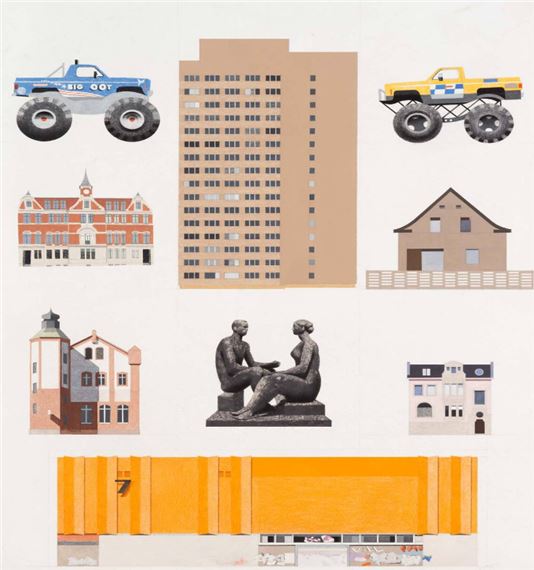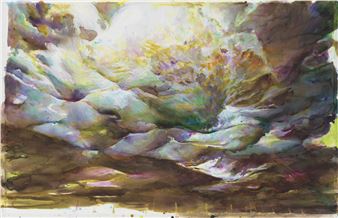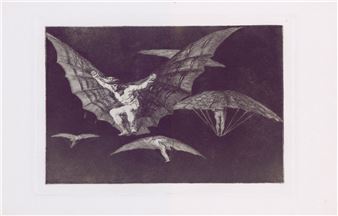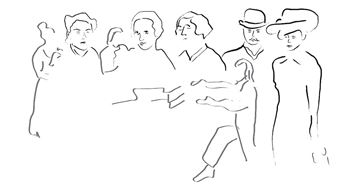Robert Seidel: Alles gut
вҖңEverythingвҖҷs fineвҖқ вҖ“ what does that actually mean? Robert Seidel has chosen a title for his exhibition that does not necessarily describe how the overall situation is currently perceived. We are experiencing crises, upheavals, and heated debates, many of which are bitterly contested. In everyday life, however, the phrase вҖңeverythingвҖҷs fineвҖқ has become commonplace, signaling indulgence, appeasement, a certain generosity, and that something or everything is not so bad after all.
Robert SeidelвҖҷs pictures show houses, people, archives, type cases, emblems, and architectural icons. He sometimes reduces his still lifes to the depiction of a single, centrally placed object. вҖңLeipzigвҖқ lists buildings and places in the city where he studied and lives. The series вҖңTeileвҖқ (Parts) composes individual aspects of Leipzig that are clearly recognizable and refer to local history and, in particular, art history.
It took a long time to take this step, to deal with this city as his home and as the matrix of his artistic development in his painting, says Seidel. Because the city is common property, and oneвҖҷs personal view of it will always be examined, questioned, and compared with the individual experiences of the viewer.
At the same time, an image of a city is always just a snapshot. The present and memory, private moments and historical events are interwoven.
The exhibition combines documentary elements with personal touches, such as sensitive portraits of people and, in particular, still lifes of roses in a vase at the peak of their bloom. Already, their heads are bowing under the weight of their full ripeness.
Just as flowers wilt and people age, the plaster begins to crumble from the houses, the city begins to change its face, and memories begin to fade.
вҖңAlles gutвҖқ tells a mindful and respectful story of the here and now. Of how everything is in flux. Robert SeidelвҖҷs loving gaze allows us to accompany him, but also to sharpen our own view of our interconnection with the world, the city, and the passing of time.

Recommended for you
вҖңEverythingвҖҷs fineвҖқ вҖ“ what does that actually mean? Robert Seidel has chosen a title for his exhibition that does not necessarily describe how the overall situation is currently perceived. We are experiencing crises, upheavals, and heated debates, many of which are bitterly contested. In everyday life, however, the phrase вҖңeverythingвҖҷs fineвҖқ has become commonplace, signaling indulgence, appeasement, a certain generosity, and that something or everything is not so bad after all.
Robert SeidelвҖҷs pictures show houses, people, archives, type cases, emblems, and architectural icons. He sometimes reduces his still lifes to the depiction of a single, centrally placed object. вҖңLeipzigвҖқ lists buildings and places in the city where he studied and lives. The series вҖңTeileвҖқ (Parts) composes individual aspects of Leipzig that are clearly recognizable and refer to local history and, in particular, art history.
It took a long time to take this step, to deal with this city as his home and as the matrix of his artistic development in his painting, says Seidel. Because the city is common property, and oneвҖҷs personal view of it will always be examined, questioned, and compared with the individual experiences of the viewer.
At the same time, an image of a city is always just a snapshot. The present and memory, private moments and historical events are interwoven.
The exhibition combines documentary elements with personal touches, such as sensitive portraits of people and, in particular, still lifes of roses in a vase at the peak of their bloom. Already, their heads are bowing under the weight of their full ripeness.
Just as flowers wilt and people age, the plaster begins to crumble from the houses, the city begins to change its face, and memories begin to fade.
вҖңAlles gutвҖқ tells a mindful and respectful story of the here and now. Of how everything is in flux. Robert SeidelвҖҷs loving gaze allows us to accompany him, but also to sharpen our own view of our interconnection with the world, the city, and the passing of time.

 ARTISTS
ARTISTS












